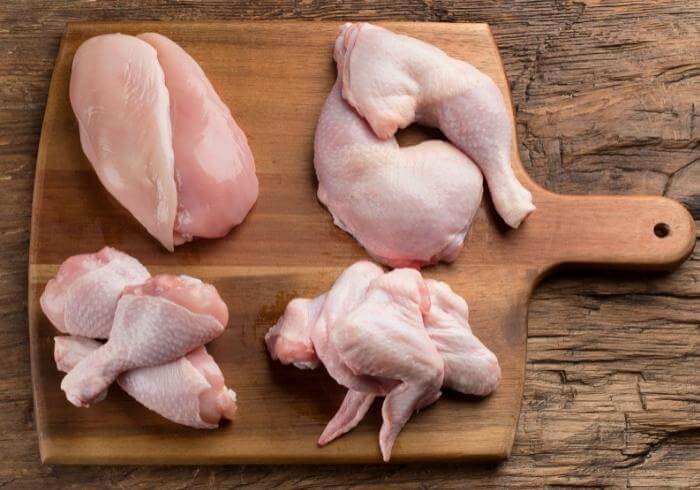Most people know that chicken needs to be cooked all the way through before eating, but many might not know how to tell if raw chicken is bad.
The best way to tell that raw chicken is bad is by its smell and discolored, slimy texture. Fresh raw chicken meat should not have much of a smell, be light pink in color, and the skin and fat should be white. If your raw chicken is gray, slimy, or has yellow spotting, then it has likely gone bad and should not be cooked or eaten. Throw it out!

Chicken can spoil quickly, so it’s important to be able to identify spoilage early on. In this article, I’ll explain spoilage and the signs that raw chicken is bad to help you avoid getting sick. And some tips on what to do with rotten chicken.
How To Know If Raw Chicken Is Bad
The Expiration Date Has Past
Most grocery stores sell raw chicken with a “sell-by” date. While this does not mean that your chicken is bad after this date, using it as quickly as possible is always a good idea.
According to USDA, you should either cook or freeze raw chicken within one to two days after purchasing it.
You never know how long chicken has been sitting chilled at the grocery store. It’s possible that another customer had it in their cart for some time and then returned it to the shelf. Or perhaps the chicken has been sitting in the back for a week. All of these will affect its shelf life.
The takeaway is that chicken is expensive, and you should process it once you get it home to avoid having to throw it out.
It Smells Bad
When raw chicken goes bad, you will definitely smell it. The smell is very distinct and can be described as sour or sometimes like rotten eggs.
If your raw chicken smells, it’s time to put it in the garbage.
However, if garbage day is a few days away, you might want to freeze the bad chicken and label it. Once garbage day comes, then toss it out while frozen.
If you leave raw chicken to rot in your garbage can, it’s going to smell extremely foul and stink up your whole kitchen.
It’s Slimy
Raw chicken can be a little slimy because when it’s packed, excess blood and fluids tend to pool in the bottom of the packaging that your butcher or grocery store receives them in.
However, slimy chicken can result from bacteria growth and spoiled meat.
This is a tricky sign because slimy raw chicken can be bad and not have much of a smell if it has been stored just above freezing. You can try pressing on the flesh to see if it is still firm and springs back. If it doesn’t, get rid of it.
If you know your raw chicken is old and wasn’t so slimy when you bought it, it’s likely bad.
I don’t advocate washing raw chicken and checking if it’s slimy after drying. Doing so can easily cross-contaminate with other food items and spread dangerous bacteria all over your kitchen.
It Has Yellow Spots
Not all yellowing is bad. Many chickens, especially young, healthy, well-fed corn chickens grown in Europe, have light yellow scaling on their legs and other parts of their body. It’s a sign of quality and sometimes confused with spoilage.
Here in the USA, our chickens usually have white skin but sometimes have a yellow tint to them as seen below.

But when raw chicken starts to get yellow spots on the flesh or spots on the skin, it has already gone bad. You can’t cut off the yellow spots and use the meat. It’s already rotten. Do not cook with it or eat it. It’s no longer safe to consume.
It’s Discolored
Raw chicken should not be discolored in any way. It should be a light pink color and may have white connective tissues or fats running through it, depending on the cut.
If it is turning gray, it’s most likely that it wasn’t stored at the correct temperature or was exposed to heat. According to the USDA, raw chicken should always be stored below 40°F in the fridge or below 0°F in the freezer.
Discolored chicken is not safe to consume even after cooking. Be careful when disposing of it, as it will likely be slimy and loaded with harmful bacteria.
It’s Freezer Burnt
If your frozen raw chicken is freezer burnt, it’s best to throw it out. Even the good-looking portions will have degraded in quality and won’t become the juicy bites you hoped for.
The freezer-burnt chicken won’t taste good once cooked. However, you can try cutting off the bad pieces to try to salvage the rest of the meat. Good luck, but it’s best to get rid of it.
Bad Raw Chicken FAQs
How Should Raw Chicken Smell?
Raw chicken shouldn’t have too much of a smell to it. If your chicken smells sour, fishy, or has any other strange odor, it’s likely bad, and you should throw it out.
What Are The Black Spots On Chicken Breast?
Black spots on raw chicken are probably blobs of coagulated blood. When blood loses oxygen, it becomes dark and could appear as black spots. Smush them between your fingertips. If it doesn’t seem like blood, don’t use the chicken.
What Does Bad Raw Chicken Look Like?
Bad raw chicken will look discolored, have yellow spots on the flesh or skin, and will be slimy. If you’re not sure if your raw chicken is still good, throw it out to avoid food poisoning or serious illness.











